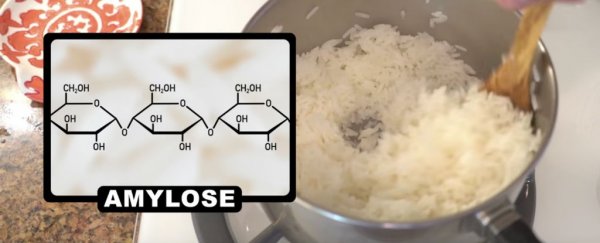As any successful baker will tell you - everything to do with food and cooking is all about chemistry, whether you're dealing with pH levels, enzymes, or good old-fashioned temperature fluctuations.
Get the balance right, and you can preserve things for longer, increase the quality of your meat, and even reduce the amount of calories you're consuming - without replacing any ingredients or restricting your portions.
In the episode of Reactions below, the American Chemical Society gives us three solid food hacks, and explains the science behind how they work.
1. Halve the calories in your rice
Rice might be a staple in many cuisines around the world, but let's face it - all the starch isn't exactly great for you. In fact, just 1 cup of cooked rice contains around 240 calories, which will be easily converted into fat if they're not burnt off.
But researchers have figured out a simple way to manipulate all that starch and make it more resistant to being broken down into glucose (calorie-laden sugars).
You'll first need to add a dollop of coconut oil to your boiling water - about 3 percent of the weight of the rice you're about to add, which is roughly a teaspoon for half a cup of rice.
Next, pour your rice in, turn the heat down to a simmer, and cook for 8-10 minutes.
When your rice is cooked, you need to put it in the fridge for 12 hours. Once that's done, you can just reheat it in the microwave to serve, and you'll be eating something with a potential 50 to 60 percent reduction in calories.
How does this work?
As the video explains, starches in rice come in digestible and indigestible varieties - digestible starches are quickly turned into glucose and stored as fat if we don't burn them up, whereas indigestible starches aren't.
The coconut oil works by interacting with the starch molecules and changing their architecture. Cooling for 12 hours then leads to the formation of hydrogen bonds between a starch component called amylose outside the rice grains, which converts them to an indigestible starch.
2. Stop fruit slices browning overnight
This is a cool twist on something you've no doubt heard before - lemon juice on sliced fruit staves off the browning. But what if you don't want your apple slices tasting overwhelmingly of lemon?
This technique involves pouring water into a small dish, and squeezing a whole lemon into the water. Dip your sliced apples or other fruit into the watered-down juice, then pack them into a zip lock bag and put them in the fridge.
This technique allows you to combat the activity of the browning enzyme polyphenol oxidase using the vitamin C of lemons, but without exposing your fruit to the full-strength juice.
3. Get juicier chicken using baking soda
If you don't have time to marinate your diced chicken or other meats, adding a small amount of baking soda to it prior to cooking can have a similar effect.
Simply dust your raw chicken with baking soda, mix it all around, cover it in cling wrap, and let it sit for 15 minutes. Afterwards, simply rinse the baking soda off, and cook the meat as normal.
As the Reactions video explains, as raw meat becomes less and less fresh, its pH levels drop, and this effects its texture - less pH means tougher meat.
But baking soda has a high pH of 9, so temporarily coating the meat in it will raise its pH levels, and actually increase its water-holding capacity. So instead of releasing water out into your pan as it cooks, the chicken will retain it, and be far more tender as a result.
Check out the video below to find out more about these three science-backed food hacks:

